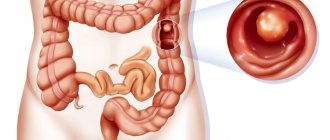Intestinal obstruction is a life-threatening pathology characterized by impaired passage of chyme (partially digested food) through the intestine. The reason for this may be various conditions that cause obstruction of the intestinal lumen, spasms, circulatory or innervation disorders. Timely access to a surgeon and establishment of an accurate diagnosis is crucial.
At CELT you can consult a surgeon.
- Initial consultation – 3,000
- Repeated consultation – 2,000
Make an appointment
Classification
The classification of intestinal obstruction is based on various factors. Accordingly, one or another treatment tactic is selected.
Depending on the cause of the pathological condition, the following types of disease are distinguished:
Dynamic intestinal obstruction (due to spasm or, conversely, decreased tone of the intestinal wall).
Mechanical, which is divided into forms:
- strangulation;
- obstructive;
- ischemic (vascular);
- mixed.
According to the level of localization of the process, the following types of obstruction are distinguished:
- high small intestinal;
- low small intestinal;
- colonic
By severity:
- partial;
- complete.
According to clinical signs:
- spicy;
- subacute;
- chronic course.
Stages of intestinal obstruction:
- It’s not for nothing that the stage of “ileus cry” bears this name. It is characterized by severe abdominal pain and lasts 2-12 hours.
- Intoxication is a period of “light” interval, when the pain syndrome subsides and intestinal peristalsis weakens. The feeling of better health is deceptive. The clinic is characterized by bloating, asymmetry of the abdomen, lack of stool and gas.
- The terminal stage is characterized by poor circulation and the development of peritonitis (inflammation of the peritoneum). It usually occurs 36 hours after the onset of the disease.
Causes of intestinal obstruction
There are many reasons that contribute to the occurrence of intestinal obstruction. Thus, its spastic form develops as a result of painful contraction of the wall caused by helminths, foreign bodies, abdominal injuries, acute inflammation of the pancreas, renal and biliary colic, pleuropneumonia, pneumothorax and other pathologies. The development of the spastic form can also be caused by various lesions of the nervous system (trauma, pathologies of the spinal cord, strokes, etc.) and circulatory disorders.
Paralysis of the intestinal wall, characteristic of the paralytic form of the disease, develops as a result of peritonitis, various poisonings, including food poisoning, after operations under anesthesia, etc.
Obstructive intestinal obstruction is caused by various kinds of obstacles to the movement of chyme. These can be fecal stones, gall bladder stones, helminths, foreign bodies, tumors growing both inside the intestine and compressing the wall from the outside.
The etiology of strangulation intestinal obstruction lies not only in mechanical compression of the intestine, but also in compression of the mesenteric vessels. This occurs as a result of the development of volvulus, strangulation hernia, intussusception, the formation of intestinal loops, which can be facilitated by a long mesentery of the intestine, scars and adhesions, rapid weight loss, severe overeating after fasting and other pathological conditions. Vascular intestinal obstruction develops due to acute disruption of mesenteric circulation as a result of thrombosis or embolism.
Consequences of intestinal obstruction
The development of obstruction triggers a cascade of pathological processes that affect the body systemically. With tumor obturation, the onset, as a rule, is blurred due to incomplete occlusion of the intestinal lumen, but as the tumor grows, the situation worsens. Acute obstruction, as a rule, develops due to complete obstruction of dense feces in the area of the intestine narrowed by the tumor.
In the first time after the development of obstruction, there is an increase in intestinal peristalsis. It's as if he wants to overcome an obstacle. As intestinal contents accumulate, the intestinal wall becomes overstretched, water-electrolyte and metabolic disturbances occur, motor function sharply weakens, and then intestinal paralysis occurs.
At the second stage, disturbances in the secretory-resorptive activity of the intestine and disturbances in parietal digestion develop, the enzymatic activity of enterocytes is blocked, as they are rejected, and the regenerative activity of the crypts is first inhibited and then completely stopped.
Under such conditions, the activity of intestinal bacteria and the so-called symbiont digestion is activated. It is not physiological and is inferior in efficiency to normal, parietal digestion. As a result, rotting and fermentation occurs, as well as the accumulation of a large number of products of incomplete breakdown of proteins, some of which have a toxic effect.
As the process progresses, the immune defense mechanisms are disrupted, which leads to the active proliferation of anaerobic bacteria that secrete exo- and endotoxins. They act systemically on the body - they disrupt tissue microcirculation, lead to central nervous system disorder, and disrupt cellular metabolism. Due to these effects, the permeability of the intestinal wall to bacteria increases, and they can spread into the abdominal cavity, blood and lymph flow, causing peritonitis and even sepsis.
Water and electrolyte disturbances also progress. Due to disruption of the intestine, increased filtration of fluid occurs; it is not absorbed back and accumulates in the afferent loop of the intestine. Under normal conditions, about 10 liters of liquid enter the gastrointestinal tract per day (including food, drink, saliva and secretions of the digestive glands). About 8-9 liters should be absorbed back, but this does not happen due to impaired reabsorption. Fluid accumulates in the adductor section of the intestine, causing it to expand. This, in turn, leads to reflex vomiting, which further worsens dehydration. Against this background, electrolyte disturbances quickly develop, which ultimately lead to renal and heart failure.
Book a consultation 24 hours a day
+7+7+78
Clinical manifestations
Manifestations of the disease develop quickly, and it is extremely important to diagnose it in a timely manner.
Characteristic clinical symptoms of intestinal obstruction can be identified:
- severe pain;
- delayed bowel movement (lack of stool and gas);
- vomit;
- flatulence.
Delayed bowel movements and lack of natural gas release are another sign characteristic of colonic obstruction and are accompanied by bloating.
Abdominal pain is a mandatory symptom of the disease. The pain syndrome is always pronounced and marks the beginning of the development of the disease; it can be constant or cramping in nature with a gradual increase in intensity, up to the development of painful shock. The patient takes a characteristic body position that brings relief - he presses his legs to the anterior abdominal wall.
Vomiting, which does not bring relief, is also characteristic of this pathology, however, you should pay attention to some features of this symptom. Repeated vomiting at the very beginning of the disease may indicate that the problem is localized in the small intestine. Pathology located in the lower sections is accompanied by infrequent vomiting, which appears at the stage of intoxication.
If the patient is not helped at the onset of the disease, intoxication occurs, the clinical signs of which are:
- increased body temperature;
- development of peritonitis;
- increased frequency of breathing (shortness of breath);
- increased heart rate (tachycardia);
- sepsis;
- urinary disturbance;
- dehydration.
In the terminal stage of the disease, death can occur.
Pyloric stenosis (high gastrointestinal obstruction)
The main threat is the complete impossibility of food passing from the stomach to the underlying sections of the gastrointestinal tract and the development of exhaustion.
- Development mechanism
Post-ulcer cicatricial stenosis of the pylorus (pyloric stenosis) or duodenum is a complication of peptic ulcer of the gastric outlet (pylorus) or duodenal bulb. A scar forms at the site of a healed ulcer, the tissue in the scar area tightens, and the passage of food from the stomach to the duodenum becomes difficult. This place is constantly injured by food masses and is affected by hydrochloric acid. Chronic inflammation occurs, the narrowing zone progresses, and the passage becomes even narrower. Then decompensation develops: food passes with great difficulty, the stomach expands and loses its peristaltic function. In patients with signs of decompensated duodenal obstruction, the stomach can reach enormous sizes, food stops passing further into the intestine, and the digestion process stops. Exhaustion sets in.
- Symptoms
The ulcer manifests itself as pain in the abdominal cavity. This could be hunger pain or pain after eating. The narrowing of the gastric outlet manifests itself as nausea and a feeling of fullness after eating. Normally, a person should wake up in the morning feeling hungry, but a patient with high obstruction wakes up with a feeling of fullness in the stomach. Decompensation of stenosis is characterized by vomiting of food eaten 2-3 hours before. Decompensation is a life-threatening condition and you should consult a doctor immediately.
- Diagnostics
In order to diagnose post-ulcer cicatricial stenosis of the gastric outlet, computed tomography with water-soluble contrast and X-ray examination with water-soluble contrast or with barium are used. To understand how long it takes for a patient to evacuate the stomach contents to the underlying sections of the gastrointestinal tract, the doctor gives the patient barium, takes an x-ray, and sees where the barium has spread. Then pictures are taken after 3, 6, 12 hours - this allows you to evaluate the dynamics of contrast passage and the degree of stenosis. At the Ilyinskaya Hospital, patients with suspected high intestinal obstruction always undergo endoscopic diagnosis: using an endoscope, the doctor accurately localizes the site of the stricture and determines the scope of surgical care.
Pyloric stenosis
Image source: Designua / Shutterstock
- Balloon dilatation of the scar stricture area
If the patient applied to the Ilyinsky hospital at an early stage of the disease and was diagnosed with compensated cicatricial ulcerative stenosis of the gastric outlet, then the patient can be offered an endoscopic treatment method - balloon dilatation of the scar stricture area. A thin endoscope is passed through the mouth into the narrowing area. Under the simultaneous control of an endoscope and x-ray, a special balloon is delivered through the instrumental channel of the endoscope to the narrowing area. The balloon is inflated, the area of stenosis is stretched, and the obstruction is resolved. The pressure in the balloon is controlled by a pressure gauge, which eliminates damage and rupture of stomach tissue. X-ray endoscopically assisted balloon dilatation of the area of scar-ulcerative narrowing of the gastric outlet or duodenal bulb is a delicate but effective operation.
- Laparoscopic pyloroplasty
If the degree of gastrointestinal obstruction does not allow balloon dilatation, but there is no serious form of decompensation yet, surgeons at the Ilyinskaya Hospital perform laparoscopic surgery on the patient - pyloroplasty. Through small incisions on the abdominal wall (about 10 mm in size), a laparoscope and surgical manipulators are inserted into the abdominal cavity. At the same time, an endoscope is inserted through the mouth into the lumen of the stomach. Using laparoscopic instruments, the surgeon dissects the narrowed area of the duodenum and the outlet of the stomach in the longitudinal direction and stitches it in the transverse direction, thereby significantly expanding the narrowing site and resolving the obstruction. The second surgeon assists him from the lumen of the stomach using an endoscope, ensuring maximum safety of the manipulations. This is a low-traumatic operation that gives a lasting positive effect.
- Laparoscopic subtotal gastrectomy
If the patient is diagnosed with a severe decompensated stage of gastrointestinal obstruction, then the above operations are not effective. In this case, surgeons at the Ilyinsk Hospital perform laparoscopic subtotal gastrectomy. The patient's stomach is greatly enlarged, its peristalsis is impaired, and food accumulates in the stomach. Therefore, the surgeon needs to resect most of this stretched and loss of function stomach. The operation is performed laparoscopically through four small incisions. The remaining part of the stomach is connected to a loop of jejunum - an anastomosis is formed. The next day after such an operation, the patient can already drink water. Every other day, he undergoes an X-ray examination with water-soluble contrast to monitor the integrity of the anastomosis. If everything is in order, then the patient is immediately allowed to eat liquid food.
Diagnostics
Diagnosis of the disease begins first of all with an objective medical examination of the patient. Tympanitis is noted by percussion along with a dull sound; characteristic noises are heard on auscultation at the onset of the disease (with increased peristalsis) and with the progression of intestinal obstruction (when there is no peristalsis). By palpation, you can determine a distended intestinal loop; in the last stage of the disease, tension in the muscles of the anterior abdominal wall. Rectal and vaginal examination during examination provides information about the presence of a tumor formation blocking the intestinal lumen.
An objective examination only presupposes a diagnosis; it is finally confirmed by laboratory and instrumental examination methods:
- General blood test (an increase in the level of leukocytes is detected, indicating an inflammatory process).
- Blood chemistry.
- Plain X-ray of the abdominal cavity (a characteristic feature is the detection of Kloiber's cups) and X-ray with contrast to diagnose the level of the lesion.
- Colonoscopy (if indicated!) and/or irrigoscopy (x-ray of the colon) examines the large intestine, and sometimes allows one to identify the cause of intestinal obstruction.
- Ultrasound of the abdominal organs and kidneys is prescribed when the presence of tumors or inflammatory foci is suspected, however, visualization is often difficult due to severe pneumatization.
In difficult situations, laparoscopic surgery is performed, which makes it possible to clarify the diagnosis and eliminate the cause of the disease.
Intestinal obstruction is differentiated from acute appendicitis, perforated ulcer, renal colic and other acute diseases of the abdominal organs.
3.Diagnosis of the disease
Diagnosis of intestinal necessity is carried out by studying general symptoms and analyzing the medical history. The doctor may ask you about any digestive problems or previous surgeries or procedures in this area. A general examination is needed to check for tenderness and distension of the abdomen.
In addition, X-rays
which may show a blockage in the small or large intestine.
A computed tomography scan
of the abdominal area will help determine whether the blockage is complete or partial.
About our clinic Chistye Prudy metro station Medintercom page!
Our doctors
Lutsevich Oleg Emmanuilovich
Chief Surgeon of CELT, Honored Doctor of the Russian Federation, Chief Specialist of the Moscow Department of Health in Endosurgery and Endoscopy, Corresponding Member of the Russian Academy of Sciences, Head of the Department of Faculty Surgery No. 1 of the State Budgetary Educational Institution BPO MGMSU, Doctor of Medical Sciences, Doctor of the Highest Category, Professor
42 years of experience
Make an appointment
Prokhorov Yuri Anatolievich
Surgeon, head of the surgical service of CELT, candidate of medical sciences, doctor of the highest category
32 years of experience
Make an appointment
Gordeev Sergey Alexandrovich
Surgeon, Candidate of Medical Sciences, doctor of the highest category
41 years of experience
Make an appointment
Grossman Stanislav Sergeevich
Surgeon, Candidate of Medical Sciences
Experience 26 years
Make an appointment
Treatment tactics
At the first symptoms of the disease, the patient must be immediately hospitalized in a hospital. Before being examined by a surgeon, it is prohibited to take painkillers or any other medications, or to cleanse the stomach and intestines, so as not to blur the clinical picture and cause harm.
If intestinal obstruction is diagnosed in its initial stage, conservative treatment methods can be used:
- Emptying the stomach and intestines from food and feces using probing and siphon enema.
- Taking antispasmodics in the presence of spasms or drugs that stimulate peristalsis in case of intestinal paresis.
- Intravenous drip infusions of saline solutions to achieve water-electrolyte balance.
- Colonoscopy for diagnostic and therapeutic purposes.
If a conservative approach to treatment does not eliminate the disease, it is necessary to think about mechanical obstruction or the development of complications and resort to surgical intervention.
The following surgical treatment options are used:
- unraveling intestinal loops;
- cutting adhesions;
- hernia repair in the presence of a hernia;
- excision of a necrotic area of the intestine;
- the application of a colostomy to remove feces outside (in case of malignant neoplasms and the impossibility of anastomosis).
After the operation, drug correction is carried out, which, as a rule, includes antibiotic therapy, detoxification measures, restoration of peristalsis, etc. The main goal of treatment is to save the patient’s life and prevent possible complications that may develop if the disease is not diagnosed and treated in a timely manner. The most life-threatening consequences are pain shock, sepsis and peritonitis.
How to treat duodenitis?
In case of acute duodenitis, the patient is advised to fast for 1-2 days . He is prescribed gastric lavage and intestinal cleansing. It is very important to adhere to bed rest . In case of exacerbation of chronic duodenitis, the patient is treated in a hospital setting. Drug therapy for both acute and chronic forms of the disease comes down to the prescription of astringents, enveloping and antispasmodic agents, as well as vitamins .
Treatment of duodenitis is complex, and diet plays an important role in it. Patients should exclude salty, fried, spicy and smoked foods from the menu, as well as garlic, mustard, canned food and marinades. In addition, alcohol is prohibited. It is recommended to eat small portions 5-6 times a day. The menu must include boiled meat and fish, oatmeal, rice, semolina and pumpkin porridge, including vegetable purees and fruit drinks, compotes from various fruits.
To prevent exacerbations, it is useful to use medicinal herbal infusions: chamomile flowers, St. John's wort, yarrow, plantain leaves and peppermint.
Back to list Previous article Next article
Preventive actions
The effectiveness of treatment depends on the etiology of the disease and the qualifications of the surgeon, because accurate diagnosis and timely and correct treatment measures minimize the likelihood of complications. It is also necessary to take into account the age of the patient: older patients have an increased risk of complications.
Prevention is aimed at treating diseases that cause intestinal obstruction:
- control of helminthiasis;
- timely diagnosis and removal of tumors;
- prevention of adhesions;
- preventing traumatic injuries;
- healthy eating;
- the right way of life.
The multidisciplinary clinic CELT has a powerful diagnostic and treatment base and experienced specialists of the highest level.
Our services
The administration of CELT JSC regularly updates the price list posted on the clinic’s website. However, in order to avoid possible misunderstandings, we ask you to clarify the cost of services by phone: +7
| Service name | Price in rubles |
| Appointment with a surgical doctor (primary, for complex programs) | 3 000 |
| X-ray of the abdominal cavity (survey) | 2 400 |
| Diagnostic laparoscopy | 40 000 — 60 000 |
All services
Make an appointment through the application or by calling +7 +7 We work every day:
- Monday—Friday: 8.00—20.00
- Saturday: 8.00–18.00
- Sunday is a day off
The nearest metro and MCC stations to the clinic:
- Highway of Enthusiasts or Perovo
- Partisan
- Enthusiast Highway
Driving directions








